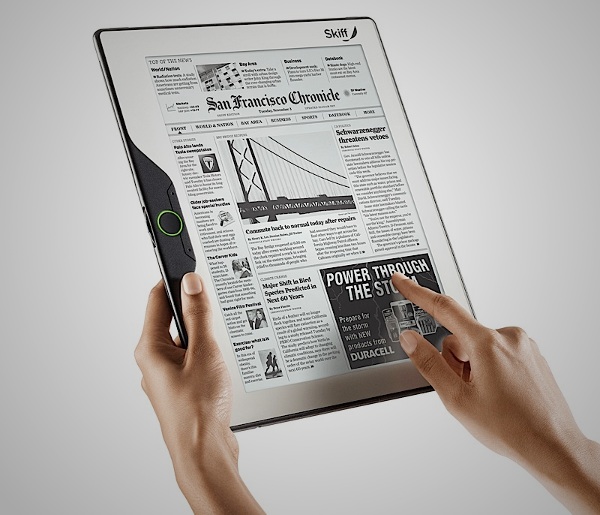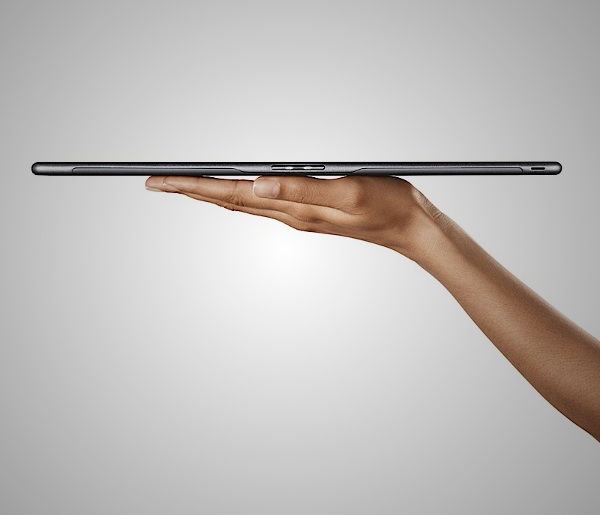- Engadget hands-on at http://www.engadget.com/2010/01/07/skiff-e-reader-hands-on-kindle-watch-out/
- The Coolist http://www.thecoolist.com/skiff-reader-the-ultimate-e-reader/comment-page-1/#comment-5042
- The Editors Web Log at http://www.editorsweblog.org/multimedia/2010/01/new_e-reader_skiff_unveiled.php
Hearst has been interested and active in eReaders longer than most "publishers" with early projects and investments in E-Ink among others. Now they are taking the step to producing their own reader and making their large catalog of content available on it.
The Display
An 11.5 inch (diagonal?) touchscreen makes it even bigger than the Plastic Logic reader "Que" (What?! :-) ).
I have yet to see technical specs and so I wouldn't be surprised if this has the Plastic Logic display in it, and hence a 10.7 inch diagonal display in an 11.5 inch overall device size.
Further reading has revealed that it's NOT a Plastic Logic display with it's organic transistors on a plastic substrate, but “silicon thin-film-transistors on a flexible steel substrate”. I'll need to review my notes to see who was working on Steel substrates, as it definately rings a bell.
The Reader
The focus (naturally) seems to be squarely on Newspaper and Magazine content, although ability to read more general content and means to get files onto the device means it could be used to support a much broader range of content types and uses.
If the screen really is 11.5 inches then the device will be large and a bit unwieldy to carry around I expect, and maybe limited to use in mainly one place, such as at home. Nice and slim at a quarter of an inch (~6mm) thick!
Leave that lying around on your couch/sofa and a bottom might put it's flexibility to the test!
Content Focus
If you want to do a reasonable job of presenting the same type of reading experience as a Tabloid or a Broadsheet newspaper then you really need a large device like this, and a reasonably high resolution - which they seem to have achieved.
Otherwise you will just have to wean us off that Newspaper layout we've been used to all our life, by presenting us some additional advantages....
Connectivity is via Wi-Fi and a Sprint Nextel 3G connection (US).
The focus on print media extends (again, naturally) right through to the use of advertising content as part of the business model. It will be interesting to see the Internet users' reactions to the ads, and how their reaction compares with their very same reactions (or lack of) when they read that same ontent in a printed newspaper or magazine. You don't hear too many gripes on the web about printed advertising, we've all grown-up with it and don't seem to mind it.
The Platform
A device being too small a concept (and business?) for Hearst, it seems this forms part of a larger, multi-device platform for delivering adverts, I mean content, (:-) ) to users where ever they are and whatever device they happen to have with them.....with apps for mobile phones, other readers, Personal Media Players (PC anyone?).
If they can do a good job of synchronizing your reading (the content you have, and where you are in each piece of content) then that will be appreciated.
One of the main problems with so many ways to consume content is avoiding sorting through or reading stuff more than once.
Different devices in that list will have different abilities to play back aspects of the Skiff multi-media content, such as Audio and Video. This device will not be able to play full-rate video with the E-Ink display, and off course all content will be monochrome (grayscale).
I wonder what Orson Wells would have to say about all this!





